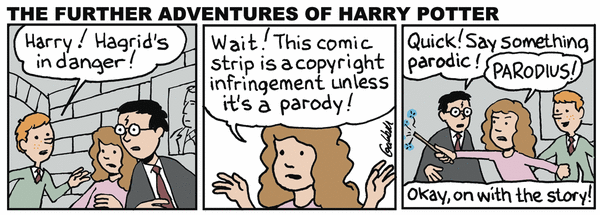Page 2: Fair Use
Unit 2, Lab 5, Page 2
MF: Can we do something to make this not just reading?
On this page, you will learn about times when it is ok to copy part of someone else’s work.
Copyright protection is not absolute. Various kinds of “fair use” are allowed by US and some other countries’ copyright laws. Here are some examples of fair use:
-
You can quote a short excerpt from someone else’s work for purposes of reviewing the original.
The definition of “short” is complicated and is different for different works. You might be able to use an entire page of a long novel, but in the picture books written for very young children, a page would be a significant fraction of the entire work, and would not be allowed. It took several lawsuits to settle whether the hip-hop technique of sampling older music was legal. (The answer: generally not, unless permission is given by both the recording artists and the song writers.)
- You can copy newspaper articles for use in teaching a class if the event reported in the article was not anticipated when you planned your class and you don’t keep using the same article year after year. (This is why BJC’s “Computing in the News” is legal, even if your teacher passes out copies of actual news articles.)
-
You can produce a parody of a copyrighted work.
The most famous case of this kind is the 2001 novel The Wind Done Gone, by Alice Randall. It retells the story of Margaret Mitchell’s 1936 novel Gone with the Wind, which concerns a wealthy slave owner from the pre-Civil-War South named Scarlett O’Hara. The Randall novel tells the story from the point of view of one of Scarlett’s slaves, Cynara. Mitchell’s estate sued Randall and her publisher for copyright violation, but Randall claimed fair use under the parody rule. After an appeals court overturned a ruling against Randall, the case was eventually settled after the publisher, Houghton Mifflin, donated part of the profits to the historically-Black Morehouse College.

Copyright 2016 by Ruben Bolling. Used by permission.
There are other ways you can use someone else’s words that aren’t technically “fair use” but are legal:
- Titles are not copyrightable at all. You can write a song and call it “She Loves You,” as long as the song itself is different from the Beatles’ version.
- You can, of course, copy anything if you get permission from the copyright holder.
-
Authors who want their works to be generally available and to be usable in ways they may not have thought of themselves, such as the authors of this curriculum, will often include with their works a general license allowing anyone to use them, such as a Creative Commons license.
IOC-1.F.5
- Creative Commons is a specific family of copyright licenses that allow others to use, share, maybe sell, and maybe revise your work.
Look at the very bottom of this page. This curriculum is under a CC-BY-NC-SA license, which is a Creative Commons (CC) license meaning that anyone can use and publish the curriculum or a modification of it, provided that they credit the authors (BY The University of California, Berkeley, and Education Development Center, Inc.), they use it not for profit (NC, non-commercially), and they license any modified version under the same terms (SA, share-alike). Because of the NC part, this is not technically a “free license,” which would allow use for any purpose (including for profit). People argue over whether it’s ethically necessary to allow that much freedom of use.
IOC-1.F.5
Ideas similar to Creative Commons are used for particular kinds of material:
- Free software means software that anyone can copy, use, modify, and redistribute, including commercially, provided that any modifications must be under the same license.
- Open source software is a more general term that means that you make the program’s source (human-readable) code available to anyone. You may still restrict how people can use the program.
- Open access scholarly research reports are available for free download, rather than requiring the permission of a journal publisher.
 Doesn’t the “provided that” make it unfree?
Doesn’t the “provided that” make it unfree?The reason for that restriction is to prevent other people from turning a modified version of the software into non-free software with restrictive licensing. That’s the only thing you’re not allowed to do: make it unfree.
 What’s the point of making it available if people aren’t allowed to use it?
What’s the point of making it available if people aren’t allowed to use it?One reason is for security software, so that people can check that the software isn’t leaking your password or other data, and will therefore trust you. (One reason many people don’t trust computerized voting machines is that their manufacturers keep their code secret.) Another reason for open source is that you’re hoping other people will contribute improvements to your proprietary software.
IOC-1.F.7
Why would an author give away the right to make copies of a work? Generally it’s because the author wants to contribute to the community, doesn’t want to be greedy, and hopes that the work will be widely used and enjoyed. Open licensing has enabled broad access to digital information.